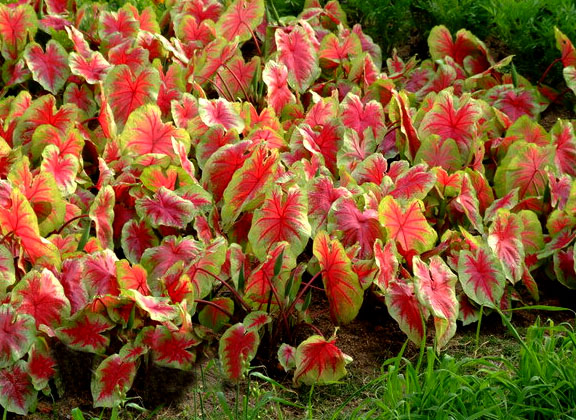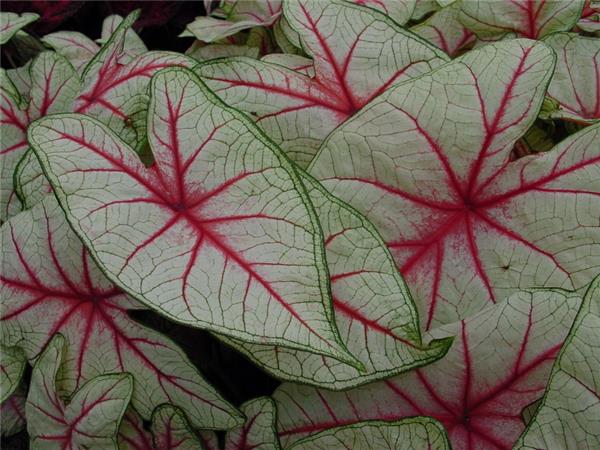Culture method of taro how to raise taro
The leaves of taro look as if they are in bloom from a distance, and they are very beautiful and moving. Now there are many different varieties of taro, and the colors of the leaves are becoming more and more varied. Breeding flower and leaf taro does not need too much trouble, so it is very suitable for decorating the house.

Variety characteristics of Amorphophallus
1. Taro leaves are flaky, dark green, with red, white or yellow lights with various transparent or opaque spots.
two。 The main vein of taro is trigeminal, the lateral veins are reticulate, the petiole is slender, cylindrical, and the base expands into a sheath with brown spots.
3. The flower leaf taro Buddha flame inflorescence is basal, the lower part of the flame bud is tubular, the outside is green, the inner face is green-white, the base is bluish purple, white, the fleshy spike inflorescence is slightly shorter than the flame bud, with a short handle.
4. Taro flowers are unisexual without perianth, female peanuts in the lower part of the inflorescence, male flowers in the upper part of the inflorescence, and separated by sterile neutral flowers in the middle. Neutral flowers with staminodes.
5. The flower, leaf, taro and berry are white, and the flowering period is 4 mi 5 months.

The main varieties of taro
1. White leaf taro: the leaves are white and the veins are emerald green.
two。 Bright white leaf taro: the leaf white is translucent and semi-bright.
3. East lamp: the middle of the leaf is crimson, the edge is green.
4. Seagulls: dark green leaves, with prominent white veins, bicolor.
5. Hongyun: the leaves have erythema.
Propagation methods of Colocasia esculenta
1. Split propagation: before the tuber sprouts from April to May every year, peel off the small tubers around the tuber, then smear the wound with plant ash or sulfur powder, dry it for several days, wait for the wound to dry and plant it in a pot.
two。 Split propagation: if it is a mother ball with larger tubers and more bud points, you can use a knife to cut the mother ball into pieces and propagate. Pay attention to ensuring that each cut has 2-3 bud points, and then put it on the basin after the section is dried and healed.
3. Sowing and propagation: because the seeds of colored-leaf taro are not easy to store, they should be sowed and propagated immediately after harvest, otherwise the germination rate will be greatly reduced.

Culture methods of Amorphophallus
1. Soil: flower-leaf taro is not tolerant to salinity and barren, so it is necessary to choose fertile and loose loam with certain water retention capacity when planting. It can be a mixture of garden soil, rotten leaf soil, river sand or perlite. The choice of flowerpot can be cultivated with white plastic pot or white porcelain pot.
two。 Temperature: taro likes high temperature, the suitable temperature for growth is 25-30 ℃, and it is not resistant to cold. When the temperature is below 15C, the leaves of taro will gradually fade, turn yellow, wilt and soften. During the high temperature in summer, measures such as shading, spraying water and strengthening ventilation should be taken to reduce the temperature and increase the air relative humidity to facilitate the growth of plants.
3. Illumination: taro likes to scatter light, avoid sunlight exposure, so pay attention to shading when cultivating taro, avoid strong light, otherwise the leaves will become yellowish, the beautiful markings on the leaves will become dim and dull, and even the tender leaves will be burned. But should not be too shady, otherwise the petiole is easy to grow and become thin and soft, and easy to break, while losing bright color and luster.
4. Watering: the flower and leaf taro likes the wet soil environment and is extremely intolerant to drought, so we should pay attention to watering when breeding. Watering should be mastered "dry and wet and wet". At the end of autumn, watering should be reduced and the basin soil should be properly dried. Usually, when breeding taro, we should also pay attention to spraying water around the plant to increase the air humidity and make the plant grow more exuberantly. When spraying water, do not spray water on the leaf surface, otherwise the leaf is easy to produce focal spots.
5. Fertilization: flower and leaf taro prefer fertilizer, and phosphorus and potassium fertilizer is applied 1-2 times every half month during the growth period, in order to make the speckle color of the leaf more bright. When fertilizing, we should avoid the liquid fertilizer on the leaves, otherwise the leaves are easy to produce scorch spots. After autumn, potash fertilizer was applied 1-2 times to promote tuber hypertrophy.

6. Pruning: taro can be properly pruned in the process of growth, which is beneficial to the growth of the plant. It is mainly to cut off withered and yellow leaves, old leaves and overdense leaves to promote the production of new buds.
7. Disease and pest control: taro mainly has dry rot, leaf spot and red spider and other diseases and insect hazards, breeding should pay attention to observation, early detection and early treatment.
It seems that taro is really a kind of plant that can attract people's attention only by flowers and leaves, which is one of the best among the species of foliage plants. After understanding this knowledge of taro, I hope that if you like this plant, you can refer to the above introduction to cultivate it.
I hope that if you like this plant, you can refer to the above introduction to cultivate it.
- Prev

[culture methods and matters needing attention of Milan flowers] how to raise Milan flowers
[culture methods and matters needing attention of Milan flowers] how to raise Milan flowers
- Next

Stripes 12 rolls how to raise stripes 12 rolls of leaves yellow how to do
Stripes 12 rolls how to raise stripes 12 rolls of leaves yellow how to do
Related
- Wuhan Hospital Iron Tree Blooming Result Was Instantly Frightened by the Gardener Master
- Which variety of camellia is the most fragrant and best? Which one do you like best?
- What is the small blue coat, the breeding methods and matters needing attention of the succulent plant
- Dormancy time and maintenance management of succulent plants during dormancy
- Minas succulent how to raise, Minas succulent plant pictures
- What are the varieties of winter succulent plants
- How to raise succulent plants in twelve rolls? let's take a look at some experience of breeding twelve rolls.
- Attention should be paid to water control for succulent plants during dormant period (winter and summer)
- Watering experience of twelve rolls of succulent plants
- Techniques for fertilizing succulent plants. An article will let you know how to fertilize succulent plants.

